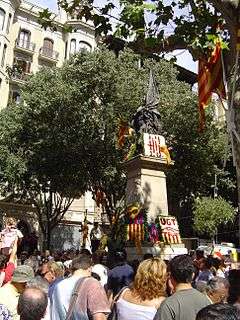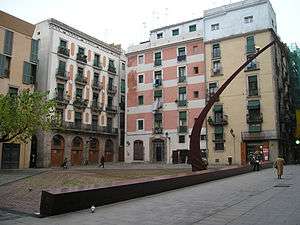National Day of Catalonia
The National Day of Catalonia[1] (Catalan: Diada Nacional de Catalunya [diˈaðə nəsi.uˈnal də kətəˈluɲə]) is a day-long festival in Catalonia and one of its official national symbols, celebrated annually on 11 September. It commemorates the fall of Barcelona during the War of the Spanish Succession in 1714 and the subsequent loss of Catalan institutions and laws.[2]
| National Day of Catalonia (Catalan: Diada Nacional de Catalunya) | |
|---|---|
 Floral offerings to the monument of Rafael Casanova, one of the commanders of the Catalan army during the Siege of Barcelona in Barcelona, 2005 | |
| Official name | Diada Nacional de Catalunya |
| Also called | Diada, Onze de Setembre |
| Observed by | |
| Type | National Day |
| Significance | Commemorates the fall of Barcelona during the War of the Spanish Succession in 1714. |
| Celebrations | Flag hoisting, floral offerings, singing patriotic songs and Els Segadors, speeches, demonstrations, entertainment and cultural programs |
| Date | 11 September |
| Frequency | annual |
History
The Army of Catalonia that initially fought in support of the Habsburg dynasty's claim to the Spanish throne were finally defeated at the Siege of Barcelona by the army of the Bourbon king Philip V of Spain on 11 September 1714 after 14 months of siege. That meant the loss of the Catalan constitutions and the institutional system of the Principality of Catalonia under the aegis of the Nueva Planta decrees, and the establishment of absolutism.[3]
The holiday was first celebrated on 11 September 1886. In 1888, coinciding with the inauguration of the Barcelona Universal Exposition, a statue in honor of Rafael Casanova was set up, which would become the point of reference of the events of the Diada. The celebration gained popularity over the following years; the Diada of 1923 was a great mass event, with more than a thousand floral offerings, acts throughout Catalonia and a certain institutional participation. But the demonstrations caused 17 wounded, five policemen and 12 protesters, and several arrests. The dictatorship of Primo de Rivera banned the celebration. During the Second Spanish Republic (1931–1939), the Generalitat de Catalunya (the autonomous government of Catalonia) institutionalized the celebration.[4]
It was suppressed by Francoist Spain in 1939, and relegated to the family and private sphere, but continued to be celebrated clandestinely. The monument of Rafael Casanova was removed. Since 1940 the National Front of Catalonia took advantage of the day to carry out some propaganda actions: distribution of anti-fascist leaflets, clandestine hanging of senyeres, etc. It was celebrated publicly for the first time again on 11 September 1976, followed by a huge demonstration demanding Catalan autonomy in Barcelona the next year, on 11 September 1977, in which the Casanova's statue was repositioned in its place, and the celebration was reinstated officially in 1980 by the Generalitat de Catalunya, upon its restoration after the Francoist State, becoming the first law approved by the restored Parliament of Catalonia.[5]
Celebrations
Nationalist organizations, political parties and institutions traditionally lay floral offerings at monuments of those who led the defence of the city such as Rafael Casanova and General Moragues, marking their stand against the king Philip V of Spain. Typically, Catalan nationalists organize demonstrations and meet at the Fossar de les Moreres in Barcelona, where they pay homage to the defenders of city who died during the siege and were buried there. Throughout the day, there are patriotic demonstrations and cultural events in many Catalan villages and many citizens wave senyeres and estelades. The event has become more explicitly political and particularly focused on independence rallies in the 2010s.[6]
Gallery
- National Day of Catalonia gallery
 Fossar de les Moreres, general view
Fossar de les Moreres, general view- Balconies showing a great number of senyeres, 2012
.jpg) Floral offerings to the monument of Rafael Casanova by President of Catalonia, Artur Mas, in 2013. On the right, Mossos d'Esquadra in gala dresses
Floral offerings to the monument of Rafael Casanova by President of Catalonia, Artur Mas, in 2013. On the right, Mossos d'Esquadra in gala dresses Independentist demonstration during the Diada of 2015
Independentist demonstration during the Diada of 2015
References
- National Day of Catalonia - Generalitat de Catalunya Archived 7 July 2014 at the Wayback Machine
- When the Treaty of Utrecht was signed between April and July, the Principality of Catalonia remained (alongside Majorca) the only realm of which still fought for the cause of Charles III. By 9 July, the General Estates of Catalonia decided to continue the war in order to defend the Catalan constitutions
- Mercader, J. Felip V i Catalunya. (Barcelona, 1968)
- La conmemoració durant la Segona República i la Guerra Civil. arxiuhistoric.bcn.cat
- "Onze de Setembre" Archived 10 December 2011 at the Wayback Machine, in: Gran Enciclopèdia Catalana (online)
- Jones, Sam (10 September 2017). "Catalans to celebrate Their National Day with Independence Protests". The Guardian. Guardian Media Group.
External links
- National Day of Catalonia
- Documents about the case of the catalans dated on 1714, at the House of Lords, UK.
- Journal of the House of Lords: volume 19, 2 August 1715, Further Articles of Impeachment against E. Oxford brought from H.C. Article VI.